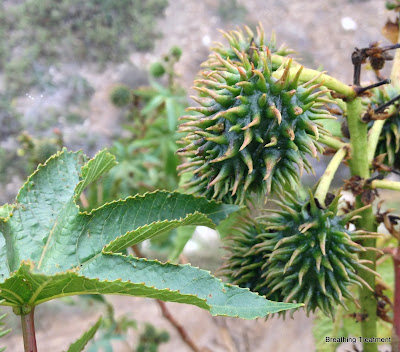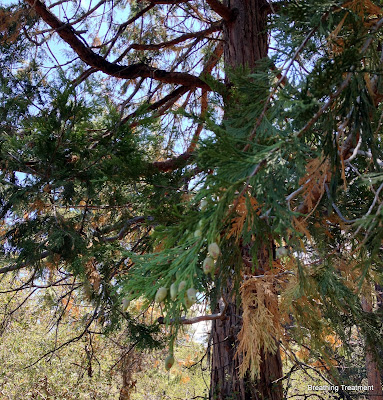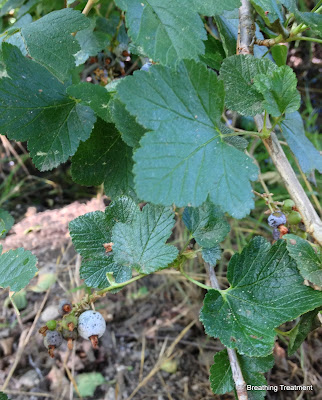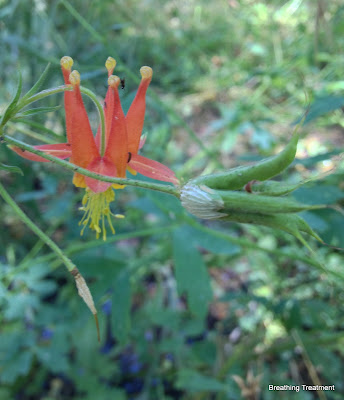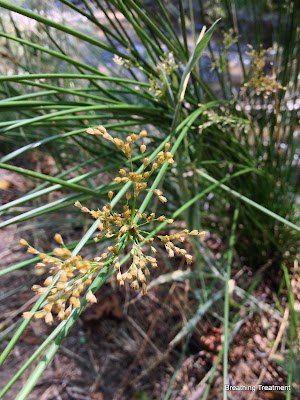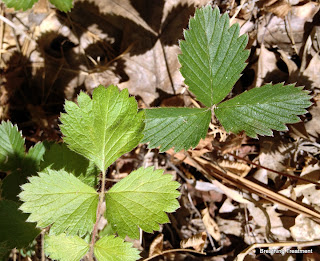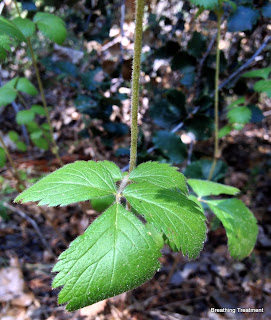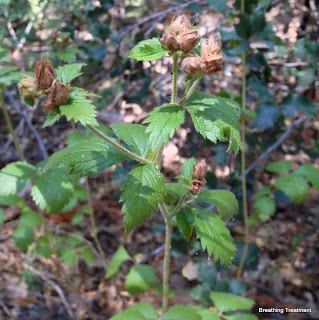I volunteer in a local canyon that is owned by a land conservancy. My charter is to survey invasive plants and I do so about once per month, hiking around and doing a little bit of wild gardening to encourage recovery of the local native plants. I wish I had more time to spend there, so I'm always looking for ways to multiply my efforts. I may have found an unwitting ally. Here's how:
Last month I noted in my report the the land conservancy that the castor beans (castor plant or Ricinus communis, a plant from eastern Africa that is considered invasive) were going to seed that that the small to medium sized plants were easy enough to pull from the loose, sandy, soil.
This month I returned to see that the conservancy had been working in the canyon while I was gone and had done extensive cutting of many invasive plants - mostly anise (Foeniculum), which had immature seeds. (By doing this work they were preventing the seeds from spreading further.)
I also noted that majority of the young castor bean plants were now dead.
I thought the conservancy had sprayed them with an herbicide. Not so.
2013-08-27
2013-08-26
Weed barrier disaster
One of my neighbors thinks that essential garden elements include weed barrier cloth. They have thought this for years, since there's been no status change to this street side parking strip for at least that long. Don't do this.


- Posted from my iPhone


- Posted from my iPhone
2013-08-21
Flora of the Santa Ana River Trail - herbaceous plants
Most people know this as the Santa Ana River Trail (2E03). The sign maker apparently did not.
I've really only made educated guesses about the plant IDs, so I'd welcome disagreement; sharp-eyed readers should feel free to leave their corrections. As noted in an earlier blog post, I need to step up my photography for definitive plant ID. I'm kicking this out of draft mode because I've lost the drive to drill down on plant species for the moment.
I've really only made educated guesses about the plant IDs, so I'd welcome disagreement; sharp-eyed readers should feel free to leave their corrections. As noted in an earlier blog post, I need to step up my photography for definitive plant ID. I'm kicking this out of draft mode because I've lost the drive to drill down on plant species for the moment.
2013-08-14
2013-08-10
Beach access in Florida
This is what public beach access and dune preservation along Florida's Spacecoast look like.



The trees at right are Mangroves. The grass is oat grass.

- Posted from my iPhone



The trees at right are Mangroves. The grass is oat grass.

- Posted from my iPhone
2013-08-09
Sea oats


Floridians seem to have an awareness that their coastline is best preserved by native plants. Mangrove forests abound too.
- Posted from my iPhone
2013-08-08
2013-08-07
Flora of the Santa Ana River Trail - Calocedrus and Quercus
I've come to the conclusion that I really need to step up my photography in order to make better species ID. Too many times the ID is dependent on small features such as finding hairs on the undersides of leaves, or something equally obscure.
Hiking along the Santa Ana (or Anna) River Trail, I came across this Incense Cedar (Calocedrus decurrens) and a number of its progeny growing nearby. This is an uncommon tree at Camp Tahquitz, so I spent some time admiring it assuming it to be a singular example. Not so. Just around the corner was a dense stand of them. The smell was delightful!
More after the break
Hiking along the Santa Ana (or Anna) River Trail, I came across this Incense Cedar (Calocedrus decurrens) and a number of its progeny growing nearby. This is an uncommon tree at Camp Tahquitz, so I spent some time admiring it assuming it to be a singular example. Not so. Just around the corner was a dense stand of them. The smell was delightful!
More after the break
2013-08-05
Flora of the Santa Ana River corridor
Found in the riparian corridor along a very short stretch of the Santa Ana river in Barton Flats.
Rosa (perhaps R. californica or, more likely, R. woodsii ssp. ultramontana):
I'm certain this is Ribes nevadense (Sierra currant, mountain pink currant):
Aquilegia formosa (Columbine, Crimson Columbine, Sitka columbine, western columbine):
Perhaps a Juncus? Maybe even J. effusus (Bog Rush, common bog rush, common rush).
Rosa (perhaps R. californica or, more likely, R. woodsii ssp. ultramontana):
I'm certain this is Ribes nevadense (Sierra currant, mountain pink currant):
Aquilegia formosa (Columbine, Crimson Columbine, Sitka columbine, western columbine):
Perhaps a Juncus? Maybe even J. effusus (Bog Rush, common bog rush, common rush).
2013-08-04
Flora of Camp Tahquitz - Ribes, Quercus, Sambucus, and Solidago
I was back at Camp Tahquitz recently and took a few more plant photos, which I've identified to the best of my ability. As always, if you have a different opinion, I'd like to hear from you.
Ribes cereum (wax currant). This is one of three types of Ribes (goosberries and currants) that exist around camp.
A nearby oak is identified by sign as Canyon Live Oak (Quercus chrysolepis, Canyon Oak, Maul Oak, Goldcup Oak, Gold cup Live Oak, canyon live oak, gold cup oak). Q. chrysolepsis exist nearby, but from what I can tell they have a much smoother edge to their leaf.
So while I think it's definitely an oak (Quercus), I think it's a different species of oak. Candidates that are locally known and reported on Calflora are Quercus dumosa (Nuttall's scrub oak, coastal sage scrub oak, scrub oak) and Quercus wislizeni var. frutescens (Chapparal Oak, Live oak, bush interior live oak, interior live oak). Q. dumosa is the best match with regard to the size of the tree and leaf colors, but it's clearly competing for sun and nutrients with the larger pine that it grows beneath, so I don't want to put too great an emphasis on size. Another possibility is that this is a hybrid; oaks commonly hybridize. It's interesting that all the oaks noted are at the upper end of their standard elevation range according to CalFlora.org, yet they are reported in Barton Flats by reputable sources.
There's a nice Elderberry (Sambucus nigra ssp. caerulea or Sambucus mexicana, blue elderberry) in camp which I mentioned previously, but did not show in pictures.
Elsewhere in camp (where it is sunnier) what appears to be the same plant is in bloom. In bloom it is much more easily and clearly identifiable as Goldenrod (Solidago - probably S. confinis, southern goldenrod).
Ribes cereum (wax currant). This is one of three types of Ribes (goosberries and currants) that exist around camp.
A nearby oak is identified by sign as Canyon Live Oak (Quercus chrysolepis, Canyon Oak, Maul Oak, Goldcup Oak, Gold cup Live Oak, canyon live oak, gold cup oak). Q. chrysolepsis exist nearby, but from what I can tell they have a much smoother edge to their leaf.
So while I think it's definitely an oak (Quercus), I think it's a different species of oak. Candidates that are locally known and reported on Calflora are Quercus dumosa (Nuttall's scrub oak, coastal sage scrub oak, scrub oak) and Quercus wislizeni var. frutescens (Chapparal Oak, Live oak, bush interior live oak, interior live oak). Q. dumosa is the best match with regard to the size of the tree and leaf colors, but it's clearly competing for sun and nutrients with the larger pine that it grows beneath, so I don't want to put too great an emphasis on size. Another possibility is that this is a hybrid; oaks commonly hybridize. It's interesting that all the oaks noted are at the upper end of their standard elevation range according to CalFlora.org, yet they are reported in Barton Flats by reputable sources.
There's a nice Elderberry (Sambucus nigra ssp. caerulea or Sambucus mexicana, blue elderberry) in camp which I mentioned previously, but did not show in pictures.
The plant pictured below was a bit of a puzzle, and I mentioned my guess in a previous blog post that it was Solidago (Goldenrod). I based that on the following series of observations:
2013-08-03
Strawberries vs. Cinquefoils
I recently stated that woodland strawberry (Fragaria vesca) and sticky cinquefoil (Drymocallis glandulosa) could be confused if one were to ignore the prominent flower spikes on the Cinquefoil. While hiking on the Santa Ana River Trail I came across a large patch of Fragaria with prominent flower spikes. "Oh no," I thought, "this can't be Fragaria." And it wasn't. Phew. Apparently they like the same growing conditions and happily intergrow. The opportunity to look at them side by side gave me new insight into their differences and they aren't so close in appearance that they can't be distinguished by a keen observer.
Above is a picture of a Strawberry leaf (upper right - three somewhat elliptical leaves touching at the stem end) and three leaved of Cinquefoil (lower left - rounder leaves lighter in color and not touching at the stem end).
A patch of Fragaria is always low-growing. The tallest spike in the above photo is somewhat out of focus at center front. It has to be all of 4" tall.
Cinquefoil leaves on a stalk. It goes up and up to where the flowers are:
Cinquefoil has these characteristic flower stalks. I haven't seen any in the prime of flowering, only with these typical dried blooms.
Above is a picture of a Strawberry leaf (upper right - three somewhat elliptical leaves touching at the stem end) and three leaved of Cinquefoil (lower left - rounder leaves lighter in color and not touching at the stem end).
A patch of Fragaria is always low-growing. The tallest spike in the above photo is somewhat out of focus at center front. It has to be all of 4" tall.
Cinquefoil leaves on a stalk. It goes up and up to where the flowers are:
Cinquefoil has these characteristic flower stalks. I haven't seen any in the prime of flowering, only with these typical dried blooms.
2013-08-01
Artemisia leaf variation
I've been pondering on Artemisia. I believe the picture below is Artemisia, A. douglasiana (Mugwort, California Mugwort, Douglas' sagewort) if I'm not mistaken. I took it while on a recent hike in Barton Flats. But the leaf shapes are so very different!
Artemisia grows by rhizomes, and these two appeared at the edge of a large patch. One would expect a plant that grows by rhizomes to be genetically identical across the entire patch. Yet I noted similar leaf variation in Artemisia I found at nearby Camp Tahquitz. So what leads to this observed leaf variation?
My naive ideas:
Older leaves develop the lobed character. Young leaves don't have it.
These are actually genetically distinct plants and the lobed leaves are highly variable.
Lobed character is dependent upon the growing conditions (unlikely, since these are so close together)
These aren't both Artemisia. (always a possibility, but unlikely since the lower leaves on both plants are lobed)
Variability in the leaf is indicated in the Calflora database too, both in photos and in their link to the Jepson manual treatment, which seems to allow for 3 to 5 or more lobes: "Leaf: evenly spaced, 1–11(15) cm, narrowly elliptic to widely oblanceolate, entire or coarsely 3–5(+)-lobed near tip, ± sparsely tomentose adaxially, densely white-tomentose abaxially."
There's some new vocabuluary for me there, so here's a translation:
"Leaf: evenly spaced, 1–11(15) cm, narrowly elliptic to widely oblanceolate [pointed more narrowly at the stem end], entire or coarsely 3–5(+)-lobed near tip, ± sparsely tomentose [matted hairs] adaxially [stem-facing, esp on top of leaf], densely white-tomentose abaxially [away from stem facing, esp on bottom of leaf]."
I actually own a bound copy of Jepson, purchased against the day that I might have to resort to it. I guess that day has come. Still, the single pointed leaf isn't explicitly called out in Jepson. In the photo you can see that the lower leaves of both plants are lobed.
So, does anyone know why the leaves in this photo look so different?
Artemisia grows by rhizomes, and these two appeared at the edge of a large patch. One would expect a plant that grows by rhizomes to be genetically identical across the entire patch. Yet I noted similar leaf variation in Artemisia I found at nearby Camp Tahquitz. So what leads to this observed leaf variation?
My naive ideas:
Older leaves develop the lobed character. Young leaves don't have it.
These are actually genetically distinct plants and the lobed leaves are highly variable.
Lobed character is dependent upon the growing conditions (unlikely, since these are so close together)
These aren't both Artemisia. (always a possibility, but unlikely since the lower leaves on both plants are lobed)
Variability in the leaf is indicated in the Calflora database too, both in photos and in their link to the Jepson manual treatment, which seems to allow for 3 to 5 or more lobes: "Leaf: evenly spaced, 1–11(15) cm, narrowly elliptic to widely oblanceolate, entire or coarsely 3–5(+)-lobed near tip, ± sparsely tomentose adaxially, densely white-tomentose abaxially."
There's some new vocabuluary for me there, so here's a translation:
"Leaf: evenly spaced, 1–11(15) cm, narrowly elliptic to widely oblanceolate [pointed more narrowly at the stem end], entire or coarsely 3–5(+)-lobed near tip, ± sparsely tomentose [matted hairs] adaxially [stem-facing, esp on top of leaf], densely white-tomentose abaxially [away from stem facing, esp on bottom of leaf]."
I actually own a bound copy of Jepson, purchased against the day that I might have to resort to it. I guess that day has come. Still, the single pointed leaf isn't explicitly called out in Jepson. In the photo you can see that the lower leaves of both plants are lobed.
So, does anyone know why the leaves in this photo look so different?
Subscribe to:
Comments (Atom)
